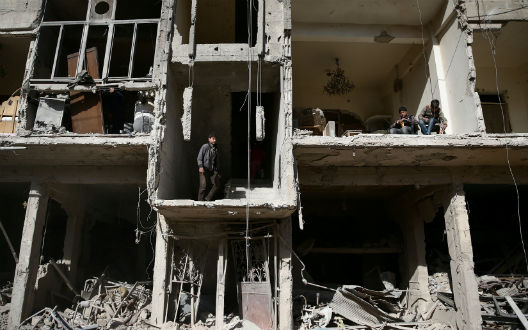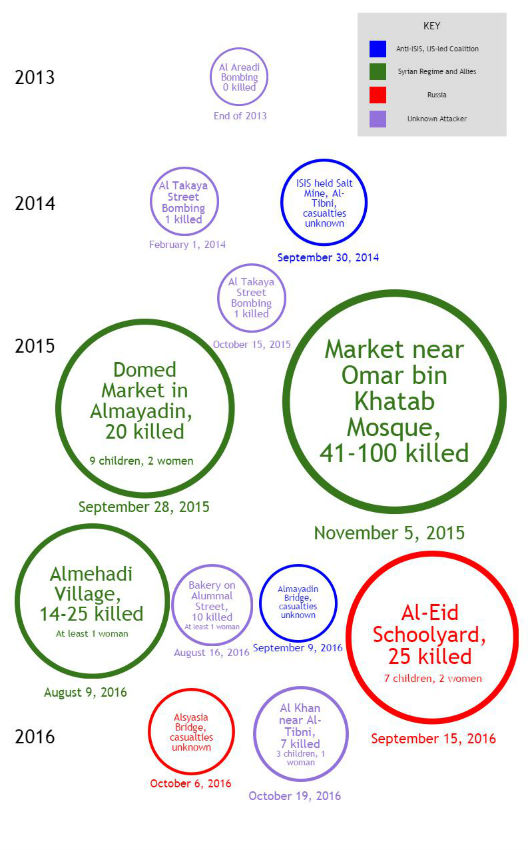 This article summarizes a report by the Justice for Life Observatory (JFL) in Deir Ezzor. The report, titled Deir EzZor: The Dust of Warplanes, catalogs bombings by all actors—Russia, the regime, and the US-led anti-ISIS coalition—in the besieged city of Deir Ezzor. However, it is not meant to serve as an exhaustive list of air strikes in the province. JFL interviewed twenty witnesses to catalogue these bombings. They faced several challenges trying to find witnesses—Deir Ezzor province is split among the Islamic State (ISIS), Syrian regime, and rebel opposition. ISIS does not reveal information about the damage from bombings. Of those whom JFL was able to contact, some were fearful of the backlash from either ISIS or government officials if their participation was discovered. Some were not fearful and wanted to participate, but technological challenges stood in their way, as it is difficult to travel in and out of the province and there were shortages in electricity and internet services.
This article summarizes a report by the Justice for Life Observatory (JFL) in Deir Ezzor. The report, titled Deir EzZor: The Dust of Warplanes, catalogs bombings by all actors—Russia, the regime, and the US-led anti-ISIS coalition—in the besieged city of Deir Ezzor. However, it is not meant to serve as an exhaustive list of air strikes in the province. JFL interviewed twenty witnesses to catalogue these bombings. They faced several challenges trying to find witnesses—Deir Ezzor province is split among the Islamic State (ISIS), Syrian regime, and rebel opposition. ISIS does not reveal information about the damage from bombings. Of those whom JFL was able to contact, some were fearful of the backlash from either ISIS or government officials if their participation was discovered. Some were not fearful and wanted to participate, but technological challenges stood in their way, as it is difficult to travel in and out of the province and there were shortages in electricity and internet services.
The aerial bombardment by all groups has led to either major or total destruction in some areas, in addition to a number of deaths and injuries and psychological disorders and trauma, especially among the youth. Regarding the infrastructure, several attacks have targeted bridges, halting the economy between the cities and the countryside, which are separated by the Euphrates. Additionally, with the bridges out of use, some civilians are unable to reach hospitals when they need medical aid.
JFL uses the testimonies of their witnesses to describe the bombings and casualties. SyriaSource summarized their data in the infographic below. While reviewing the data, both the number and destructive capacity of strikes increased at the end of 2015, with the most destructive strikes being from the Syrian regime and Russian air forces.

Many of the witnesses gave the time of day of the bombings, but there were some discrepancies among witnesses. They also noted if each area was a site for civilians or military personnel; the only site used exclusively militarily was a salt mine that the Islamic State had converted to a military headquarters. The US-led anti-ISIS coalition attacked this salt mine on September 30, 2014, but the casualties are unknown. The bakery on al-‘Ummal Street, attacked on August 16, 2016, and the al-Siyasiya Bridge, attacked on October 6, 2016 by Russia, were under Islamic State control, but frequented by civilians.
Witnesses described the regime and its allies’ “double-tap” style attacks, which occur when they bomb a particular area and then return and strike the same location after rescuers believe that it is safe to begin assisting those who were injured. This creates more casualties because there is an opportunity for those who survived the bombings to be attacked if they try to help. The witnesses to the bombings in Deir Ezzor described these double taps in the cases in which they occurred, which were the attacks in 2013; November 5, 2015; August 9, 2016; September 15, 2016; and October 19, 2016. It is interesting to note that the bombing at the end of 2013, where the attacker was unknown, there was also a “double-tap” style bombing, suggesting that it was a regime or regime-affiliate. It is also important to notice that the casualties significantly increased with each bombing after the September 2015 Russian intervention. Not only does the report depend on witness testimonies, but the photographs and maps provided give evidence to support each witness’ story.
The report outlines how these attacks have violated international human rights laws. The International Committee of the Red Cross described the situation in Syria as an internal armed conflict with non-international character. JFL uses this description and the Geneva Conventions of 1949 and its Additional Protocols—both of which were ratified by Syria and Russia—to describe the human rights violations. Article Three of the Geneva Conventions states, “Persons taking no active part in the hostilities, including members of armed forces who have laid down their arms and those placed ‘hors de combat’ by sickness, wounds, detention, or any other cause, shall in all circumstances be treated humanely, without any adverse distinction founded on race, colour, religion or faith, sex, birth or wealth, or any other similar criteria.” Therefore, JFL argues that the bombing of civilian areas, even if held under ISIS control, violates Article 3 because the civilians being targeted are not taking active part in the violence. JFL, recognizing that the conflict has become international in character with the entrance of Russia and the US-led anti-ISIS coalition since 2012, states that they must also apply and respect international humanitarian law.
JFL Observatory is a non-profit, non-governmental organization concerned with promoting human rights in Syria by documenting violations and working with local communities to build a base for human rights activities. The work and reports which they put out are a way to promote Syrian activists by assisting in peace building and achieving justice. A full copy of their report can be downloaded here.
Brittany Keroack is an intern at the Rafik Hariri Center.
Image: Photo: People inspect a damaged building after strikes yesterday on the rebel held besieged city of Douma, in the eastern Damascus suburb of Ghouta, Syria November 22, 2016. REUTERS/Bassam Khabieh
